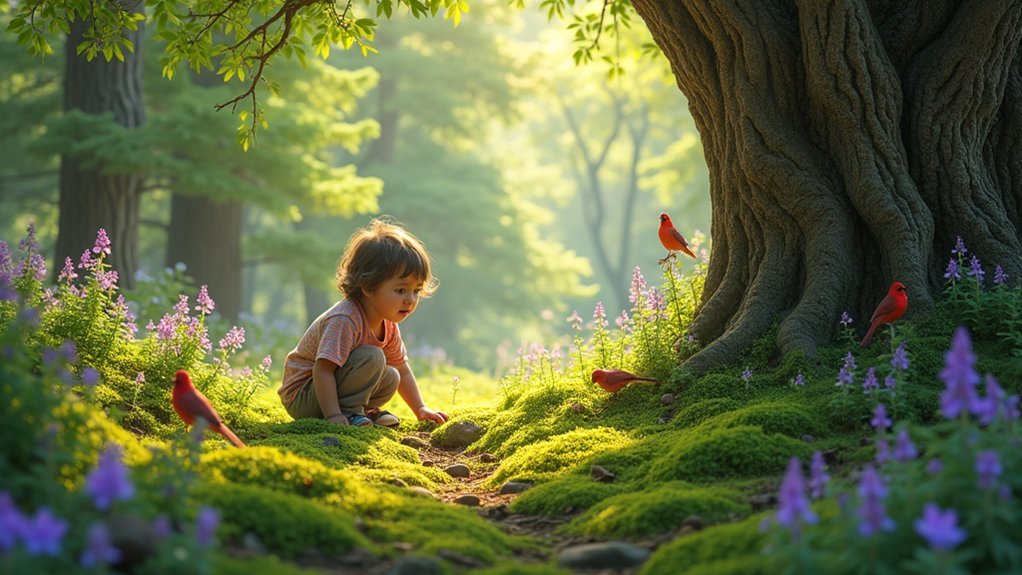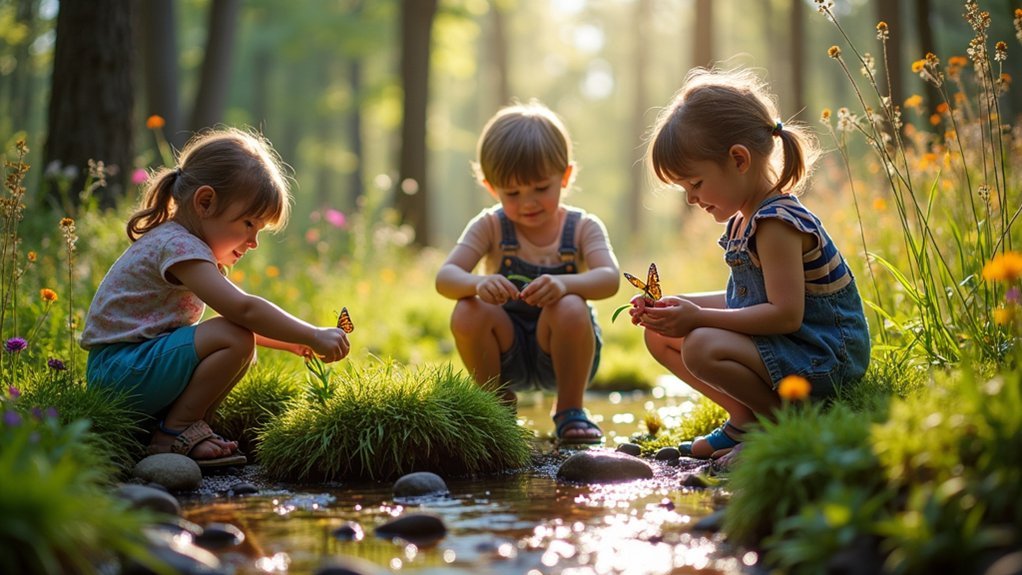Nature scavenger hunts offer powerful sensory processing support for children. Try a Touch-Based Nature Hunt where kids find and describe different textures like smooth stones or rough bark. Implement a Sound Safari to develop auditory processing by identifying bird calls and rustling leaves. Create a Visual Treasure Hunt focusing on specific colors and patterns in natural settings. Each activity builds sensory integration skills while fostering a connection to the outdoors. Discover how these simple activities transform development through natural exploration.
Touch-Based Nature Hunt: Exploring Different Textures in the Wild

Nature’s tapestry offers an incredible range of textures waiting to be discovered by curious fingers. A touch-based nature hunt invites children to engage with their environment through tactile exploration, feeling smooth stones, rough bark, soft moss, and prickly pine cones.
This sensory scavenger hunt develops fine motor skills as children manipulate different objects, pinching, grasping, and handling various natural materials. You’ll notice children expanding their vocabulary as they describe what they’re touching—”sticky,” “bumpy,” “silky,” or “grainy.”
For inclusive participation, consider adding tactile markers to guide children with vision impairments. The variety of textures encountered during these hunts can also support emotional regulation, providing calming or stimulating sensory input depending on your child’s needs.
Sound Safari: Listening Adventures for Auditory Processing Development
While visual scavenger hunts capture attention, the Sound Safari takes exploration to another dimension by immersing children in nature’s symphony. You’ll watch as kids enhance their auditory processing skills by identifying rustling leaves, bird calls, and flowing water during these specialized scavenger hunts.
In occupational therapy, these listening adventures serve as powerful tools for developing sound discrimination and auditory memory. Encourage your children to compare volume levels or mimic animal sounds they hear. These activities strengthen their ability to process and respond to environmental stimuli, supporting healthy sensory integration.
The Sound Safari also promotes teamwork as participants communicate about the sounds they discover. By working together to identify nature’s acoustic treasures, children develop social skills alongside improved auditory attention—a perfect combination for holistic development.
Visual Treasure Hunt: Color and Pattern Recognition in Natural Settings

The vibrant world of natural settings provides a perfect canvas for children to hone their visual discrimination skills through targeted treasure hunts. A visual treasure hunt challenges kids to scan their environment, identifying specific colors and patterns that occur naturally outdoors.
You’ll help children develop figure-ground perception as they distinguish objects within complex backgrounds. Adjust the complexity based on age—younger children might search for basic colors while older ones can hunt for intricate patterns.
Incorporate seasonal themes to highlight how the natural world transforms throughout the year, from autumn’s golden hues to spring’s emerging patterns.
These hunts encourage active learning and sustained attention as children focus on finding visual matches in their surroundings, supporting cognitive development while fostering a deeper connection with nature.
Frequently Asked Questions
What Is the Five Senses Scavenger Hunt?
The five senses scavenger hunt is an outdoor activity where you’ll find items that engage sight, sound, touch, taste, and smell. It’s designed to help you explore your environment through sensory experiences.
How to Do a Scavenger Hunt in Nature?
To do a nature scavenger hunt, print a list of items to find, tag elements in your chosen area, and encourage using all five senses. Don’t forget to adapt for seasons and consider photo documentation.
What Are the Learning Outcomes of Nature Scavenger Hunt?
You’ll develop visual and auditory discrimination, tactile processing, and organizational skills through nature scavenger hunts. They’ll also improve your attention span, emotional wellbeing, and provide meaningful sensory engagement while connecting you with nature.
What Are Some Good Clues for a Scavenger Hunt?
You’ll find success with sensory clues like “Find something rough” or visual prompts such as “Spot a red flower.” Try riddles, auditory challenges, or size comparisons like “Find a leaf bigger than your hand.”
In Summary
Nature’s classroom helps you fine-tune your child’s sensory processing in fun, engaging ways. Whether they’re feeling rough bark, listening for birdsong, or spotting colorful flowers, these scavenger hunts provide valuable sensory input while creating wonderful memories. You’ll notice improved focus and regulation as they explore the natural world. Try one hunt today and watch their confidence grow with each new discovery.





Leave a Reply